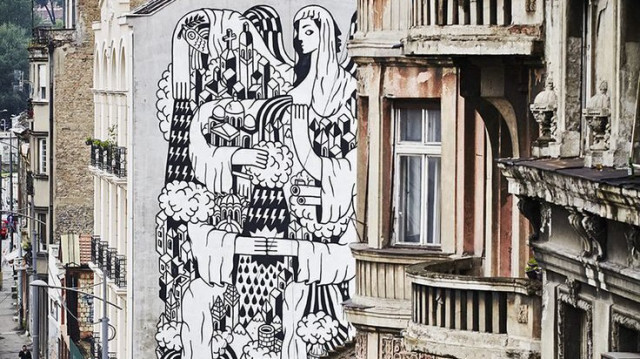
Belgrade, Serbia's capital, offers a feast for the eyes and heart with its rich history and culture manifesting in vivid street murals that dot the city.
With a population of nearly 1.5 million, Belgrade's residents live among architectural works from past centuries, spanning the Ottoman Empire, Austria-Hungary, and the Socialist Federal Republic of Yugoslavia eras.
One of the most remarkable and consistent features of the city has been the vivid murals decorating the walls and facades of the historical capital.
Belgrade's murals developed through several periods, with some of the most important turning points being a Cold War-era summit of non-aligned countries, as well as ballet festivals in 2008 and 2009.
As the capital of Yugoslavia, Belgrade hosted the Ninth Summit of the Non-Aligned Movement on Sept. 4-7, 1989. This summit, along with the later ballet festivals, rekindled interest in murals and street art in Belgrade, according to artist and researcher Jana Danilovic.
Speaking to Anadolu, Danilovic said Belgrade's street art scene is "really comparable to the scene in every other bigger city in the world, with a bunch of muralists, a bunch of street artists, different languages, different topics, and with a lot of collaborations with artists worldwide."
Danilovic's childhood town played an important role in her becoming an artist. She explains, "I was lucky enough to grow up surrounded with murals in the town of Uzice and I think that, in a way, determined my interests as an adult person and as an artist."
Creating murals is both challenging and rewarding for artists. "Creating a mural, especially a large-scale mural, is really a physical thing. Because for several days, you will be working for many hours from the lift. It's physically exhausting but it's rewarding," says Danilovic, who also values the interaction with people on the streets while creating murals, describing it as "priceless."
Danilovic said that because murals are seen by all who walk the streets in a city, artists must exercise care in the way they communicate with people who might not be interested in art but will receive the message of their artwork regardless.
Social issues are of major interest to Danilovic, who has joined projects to engage with them in the past as topics of her work as an artist, including a mural of hydro plants in the mountains and another dedicated to Syrian refugees in Belgrade.
- Cultural mainstay, allure for tourists
Murals have become an integral part of Belgrade's urban fabric. Jelena Popovic, a resident, believes the city needs more murals and street art as these help achieve the difficult task of bringing people together.
"The murals are for locals, the murals for tourists, for young and elderly, simply for everyone. I cannot think of Belgrade without them," she says.
Maja Cvetinov strikes a similar tone. Cvetinov, who works as a tour guide in the city, emphasized the great interest that tourists show in the murals. "People in Belgrade are very much used to living with them as they are very well-harmonized with our streets and the architecture, but it is special to me that tourists do not miss any and pay close attention," she said.
For some, like tourist Bugra Artan, Belgrade's street art serves to bring together the city's diverse architectural magnificence from different cultures and periods.
Belgrade's architecture is a diverse ensemble of different cultures and periods. Tourist Bugra Artan describes it: "Kalemegdan Fortress takes the visitor back to the 3rd century BC Roman Empire. Then, Belgrade's first neighborhood, the Dorcol, has a traditional Ottoman architecture blend with an Austria-Hungary style. As you go further, there are extremely characteristic communist buildings all around the city, then come the murals as a cherry on top to harmonize it all."
Belgrade's street art is a mirror of the country, where different ideas and worldviews are presented in a vivid display. As Danilovic puts it, "For me, personally, what's interesting and important about murals (is that) it's just not about yourself creating art for your audience.
"You're becoming a part of the fabric of the city. You're there to stay and it no longer is exclusively your mural, it continues to live with the city, it belongs to the citizens."













